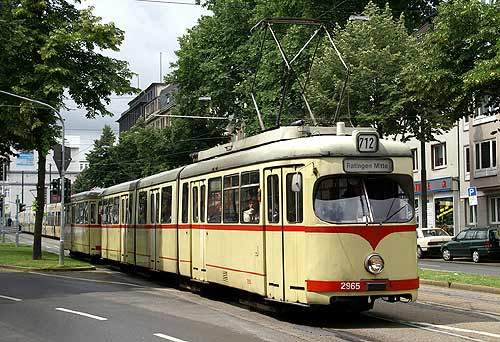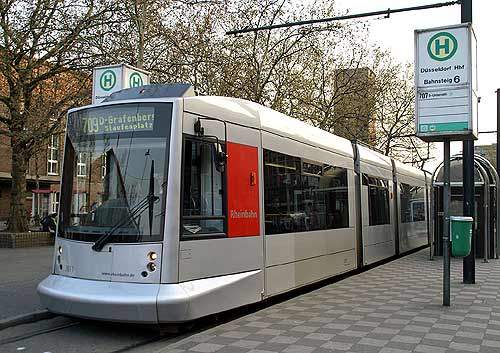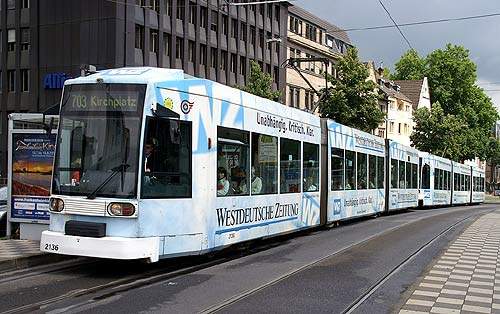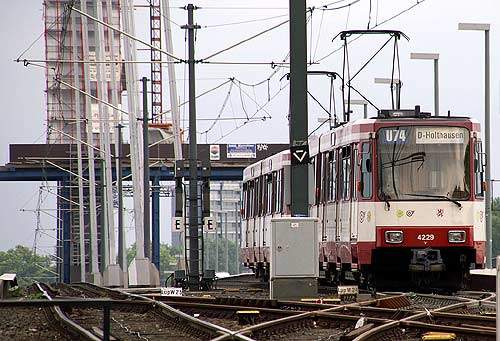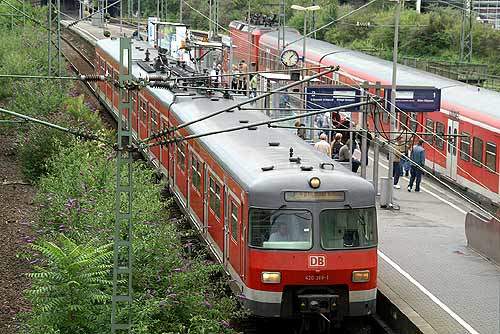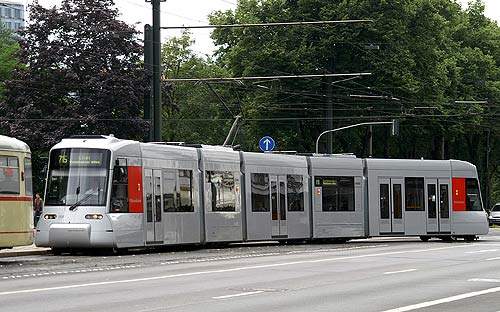Düsseldorf is the capital of Germany’s most populous state, Nordrhein-Westfalen. Located on the east bank of the Rhein, the city is close to the country’s traditional industrial heartland, the Ruhr.
Since 1980, this area’s transport has been provided by the public transport association Verkehrsverbund Rhein-Ruhr (VRR). Düsseldorf transport operator Rheinische Bahngesellschaft (Rheinbahn) is a member of this association, which also embraces the area’s intensive network of Deutsche Bahn heavy rail services.
Düsseldorf is one of Germany’s leading business centres modern economic success is largely based upon administrative and service industries.
The city’s old town and riverside location make it a year-round tourist hotspot, and it is also home to a large trade fair site (Messe) and Germany’s third-busiest airport. Düsseldorf has supported its success with a comprehensive and evolving public transport operation.
Infrastructure
At the eastern edge of the city centre, the vast Düsseldorf Central Station features long distance IC / ICE as well as S-Bahn services. Stops for the Rheinbahn-operated tram and Stadtbahn routes are located outside the station.
These visually and technically similar operations share some tracks, distinguished by signage, “U” route prefixes and differences in operating distances.
Rheinbahn began its first project in 1973, setting 1,435mm tracks below the streets using cut-and-cover techniques. Light rail vehicles remain a prominent feature of Düsseldorf’s roads, with a mix of reserved track and on-street running.
Dating from 1988, the main four-track tunnel beneath the city carries Stadtbahn services north-west from the central station towards the junction for the Krefeld / Neuss and Duisburg lines near Heinrich-Heine-Allee, on the edge of the Altstadt. The most recent tunnel section was that between the central station and Oberbilk on U74/77, opened in 2002.
One current major project is the construction of the long-envisaged Wehrhahn line. It will connect Wehrhahn, already a station on existing tram routes and an S-Bahn stop, with Bilk, which is also an S-Bahn interchange.
Construction began in February 2008, and is scheduled for completion by the middle of 2014. The line will be approximately 3.6km long, with six sub-surface stations in the two-track tunnels and the two above-ground terminals. The line is estimated to cost €650m and serve around 60,000 passengers a day.
Rolling stock
Düsseldorf’s transport managers have used local suppliers for many years. The operational fleet is composed of the products of Düwag, formed in 1935 from Waggonfabrik Uerdingen AG of Uerdingen (Krefeld) and Düsseldorfer Waggonfabrik, latterly Siemens and Vossloh-Kiepe. Platform height differences on the system are accommodated through retractable steps.
Low-floor operation began in 1996 with the delivery of NF6-type trams, although a substantial fleet of earlier high-floor types and trailers remain in service.
The Silberpfeil (Silver Arrow) styling and colour scheme that is specific to Rheinbahn began with the 100% low-floor NF10 from 2000, which is one of the system’s largest vehicles.
Some of these features continue with the most modern vehicles, the five-section NF8U (known as the Silberpfeil II), delivered in 2006-2007. The designation indicates Niederflur U-Bahn, a low-floor design for in-tunnel operation.
A winner of an international design award and with options for more to join Rheinbahn, the NF8U’s distinctive flared ends allow for bogie movement on tighter curves. Like other Rheinbahn trams, it is a single ended, although coupled pairs will allow for Stadtbahn operation. As the NF8U has become available in advance of the line for which it was intended, they have been put into service on surface route 715.
Signalling and communications
Signals for light rail operations are coordinated with road traffic signals at the many crossings on the Stadtbahn. Real-time indicators are especially important in Düsseldorf due to the widespread use of common tracks by several different routes.
Vehicles are also fitted with passenger information systems. As is widespread in Germany, travellers around Düsseldorf benefit from multi-mode ticketing at city, tariff union and regional levels.
The future
By realigning tram routes, the new line will reduce the number of changes needed via the central station. Other expansion projects being considered include links to the university, the Hafen riverside area, a U77 extension to Benrath and a river crossing that would form part of a city rail ring. A likely project is the completion of line U80 to give rail access to the Messe grounds via a 2.4km extension from the U78/79.

